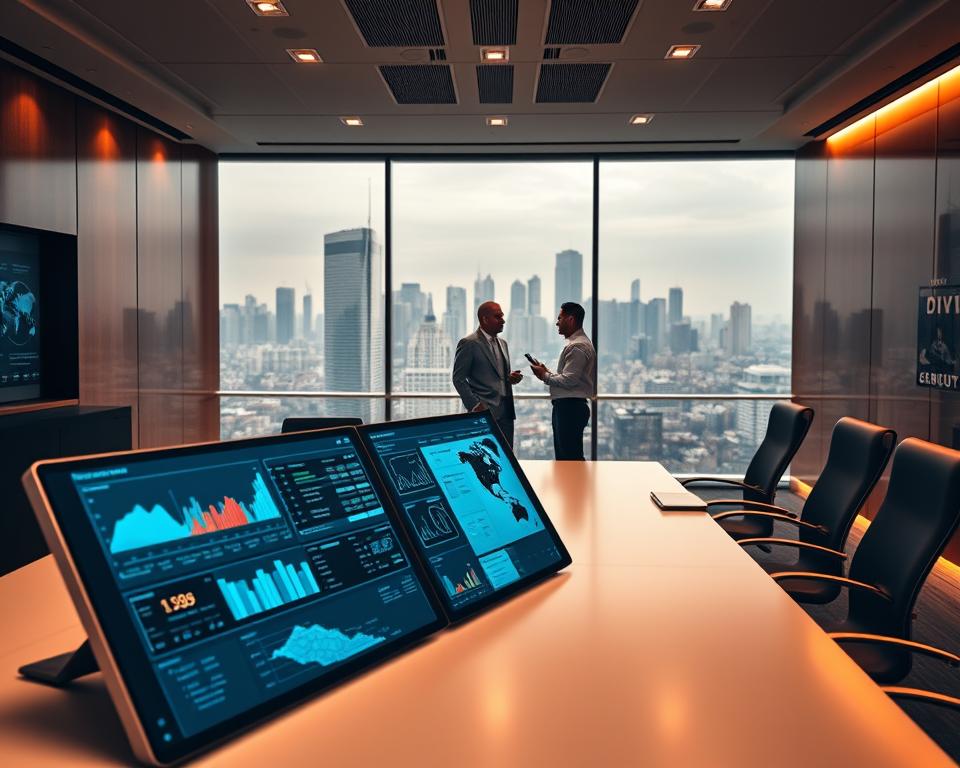Improve Your Commercial Property Protection Right Away
Consider if your present protection steps merely give a false sense of protection? A lot of entrepreneurs find weaknesses following incidents occur—a gamble no one should accept. At Divine Protection Services, we understand preventing is better than responding every time.
A strong security plan combines technology and expertise. High-tech systems like surveillance cameras and entry management systems serve as the foundation of today’s security. Yet gear alone doesn’t suffice—ongoing threat evaluations make sure those commercial security solutions adjust to new dangers.
Did you know 34% of companies revise their security procedures only post-breach? Advance servicing and specialist counsel turn fixed systems into active defenses. We excel at customizing setups that evolve with your needs, spanning stores to office complexes.
This manual reveals all details about door control to live surveillance. You will discover why merging high-end tech and tactics yields unmatched protection tiers. Let us craft a protective web that functions while you focus on what matters most—your business.
Grasping Commercial Property Safety Hazards
Daily functions often hide covert risks that imperil your company’s security. Acknowledging hazards isn’t about terror—it’s about being prepared. By seeing what may fail, you’ll design wiser barriers matched to your particular needs.
Detecting Hidden Threats
Burglary, damage, and fire hazards rank highest among worries for most locations. Recent research indicated 60% of enterprises experience vandalism bids yearly. Sophisticated CCTV systems contribute to spotting these incidents early—like catching loiterers before they act or detecting smoke patterns.

Modern tools like high-resolution security cameras catch suspicious activity before escalation. Infrared sensors within video arrays can reveal fire threats in electrical boxes—proving tech does more than watch.
Finding Weak Points in Your Space
Each facility contains blind spots. Outdated door locks, poorly lit alleys, or unmonitored storage areas often become targets. A retailer dropped break-in incidents by 40% once they improved security to eliminate blind spots.
Frequent walkthroughs by specialists expose these vulnerabilities. They examine access points, illumination, and device reactions. Schedule a review today—you may find vulnerabilities you didn’t suspect existed.
Key Components of Modern Security Systems
Envision a protective web where each strand links—surveillance systems communicate with alarms, and access points message controllers. Contemporary systems excel at coordination, merging tangible blocks with digital tech to forge unseen barriers.
Entry Regulation, Video Tracking, and Alarm Coordination
Three factors establish the current top standard. High-tech locks oversee entry points employing iris scans or mobile keys, while cameras track movements in real time. When sensors detect unauthorized access, alarm systems trigger instant alerts to both staff and responders.
Integration shortens response times. A jammed lock may trigger surrounding cameras and mute alarms for permitted users only. This synchronization erects obstacles for offenders while letting valid users circulate.
Adopting Cutting-Edge Tech
Cloud-driven platforms now combine previously isolated tools. AI scrutinizes camera output to identify odd movements—such as a person loitering by no-entry zones. These systems train on regular patterns, tailoring security as your requirements shift.
Think about adhering to professional recommendations when building your system. Pair motion-sensitive lighting with door sensors, or link smoke detectors to emergency alerts. Every component needs to work together, yielding a security net that’s challenging to breach but straightforward to operate.
Putting in Place Robust Access Control Schemes
Advanced entry controls aren’t just nice—they’re required for contemporary workflows. Regulating access to your premises goes beyond mere keys and locks. It’s about establishing layered protection that shifts to everyday requirements and surprise risks.
Biometric Entry and Smartphone Credentialing
No more misplaced keycards or shared passwords. Touch ID readers and facial biometrics confirm only authorized staff enter. A 2023 industry report found businesses using biometrics reduced unauthorized access by 65%. Mobile key apps go beyond—employees use phones to grant access and overseers see actions live.
Managing Entryways and Overseeing Access
Every door, gate, or loading dock needs tailored solutions. Smart locks with time-based restrictions prevent after-hours entry attempts. Audit logs show exactly who accessed restricted areas—and when. A freight center halved incidents by employing motion-sensing alerts at exit points.
Divine Protection Services designs systems that balance strict safety protocols with user convenience. As one manager shared, “It feels like an electronic bouncer that never takes a break.” Whether you run a tiny workspace or a vast complex, tight access control keeps your team safe and operations smooth.
Utilizing Video Surveillance for Preventive Monitoring
Up-to-date surveillance converts ordinary cameras into active sentinels. Instead of solely logging incidents, modern systems anticipate and impede them. This move from response-based to preemptive protection maintains safety without nonstop human supervision.
Live Video Monitoring and Smart Analytics
Continuous video streams with AI-enhanced analytics catch anomalies on the fly. Imagine cameras flagging unattended bags in lobbies or detecting crowd surges before they escalate. Research in 2023 found a store chain dropped theft by 38% by leveraging live alerts for suspect behavior.
Intelligent devices study your site’s usual routines. They bypass regular motion but alert staff about deviations. For instance, someone remaining by no-entry sections after close. This pinpointing lowers false notices and spots real hazards fast.
Merging CCTV with Artificial Intelligence
AI-integrated setups review footage quicker than human crews. They recognize license plates, track movement paths, and even predict potential breaches. One logistics hub slashed unauthorized entries by 52% after linking cameras to facial recognition databases.
These unions eradicate coverage holes. Wide-field lenses cover extended spaces, and thermal sensors detect heat anomalies in warehousing spots. Combined with cloud storage, you get 24/7 visibility accessible from any device.
Enhancing isn’t simply new gear—it involves smarter oversight. As one tech director noted, “Our old cameras watched problems happen. The new ones stop them.” Isn’t it time your security cameras became more proactive?
Function of On-Site Security Officers
Tech alone can’t substitute human instinct when threats arise. Even though video and alarm systems build a sturdy base, trained officers provide essential insight and agility. At Divine Protection Services, our officers combine alertness with friendliness—preserving security while fostering hospitality.
Visible Deterrence by Professional Guards
Uniformed guards curb criminal attempts before they happen. Data shows enterprises with uniformed guards suffer 47% fewer break-ins. Why? Offenders steer clear of areas with assured rapid response. Our force carries out scheduled patrols, checks shadowed spots cameras can’t see, and responds at once when alarms sound.
One fulfillment center client realized a 60% decrease in trespass events after placing guards at loading docks. The guard presence further boosts fire safety—they identify dangers like blocked egress or overheating machinery on rounds.
Improving Guest Relations and Emergency Response
Officers do more than observe—they help. From steering guests to overseeing emergencies, they serve as immediate problem-solvers. During a recent mall evacuation, our team helped 200+ shoppers exit safely while coordinating with firefighters via two-way radios.
- Instant reaction to health emergencies or disputes
- Immediate checking of alarm alerts
- 24/7 monitoring of restricted areas
As one inn supervisor noted, “Visitors relax knowing someone’s present 24/7 to assist.” Merging human awareness with devices builds layered security that adjusts to any scenario—day or night.
Augmenting Commercial Property Safety via Cybersecurity
In this interconnected era, a lone unsecured digital entry can jeopardize your entire operation. Digital attacks now accompany physical vulnerabilities, making integrated safety solutions essential. A 2023 study showed 58% of companies faced breaches that combined cyber and physical weaknesses last year.
Securing Data While Fortifying Spaces
Contemporary safety methods need to cover servers and warehouses uniformly.
Cybercriminals often go after video cameras or intelligent locks to gain access. Implementing encrypted setups blocks these stealthy hacks while supervising building entrances.
Think about how these strata act together:
- Online-integrated alarm setups signal teams of both cyber intrusions and physical trespasses
- Cloud-resident entry logs follow staff movements in both cyber and onsite spaces
- Multi-factor authentication protects sensitive files and restricted areas
Consistent firmware updates are equally important as inspecting lock sensors. One medical network averted a ransomware incident by updating surveillance cameras—a lesson in integrated upkeep. As their CIO remarked, “Our campus’s protection now kicks off with firewalls, not just fire extinguishers.”
Employee training completes the circle. Workers instructed to identify phishing attempts also improve spotting questionable guests. Divine Protection Services fuses cyber evaluation with facility checks, generating solutions where tech and teamwork protect every resource.
Formulating a Complete Emergency Preparation Plan
Crises arrive at inopportune times—they occur when you least expect. A carefully formulated approach changes disorder into managed response, securing both individuals and assets. Let’s explore how smart planning builds confidence and safety.
Egress Plans and Fire Safety Guidelines
Defined evacuation channels safeguard lives in crises. Marked pathways and regular drills ensure everyone knows where to go. A 2023 study found businesses with practiced evacuation plans reduced injuries by 73% during fires.
Fire-retardant items and smoke detection devices give crucial supplementary defense. A technology park averted catastrophe by fitting sprinklers that triggered pre-flame spread. Link them with monthly system audits to maintain preparedness.
Rolling Out Strong Alarm Protocols and Emergency Alerts
Contemporary notifications do more than beep—they direct reactions. Audio-capable platforms can relay precise directions during crises. For instance, a healthcare network uses flashing lights with voice cues to help hearing-impaired workers.
Cloud-hosted networks broadcast instant alerts to devices. These technologies helped a retail chain evacuate 300 employees during a gas leak in under four minutes. Auto notifications to first responders accelerate external help as well.
The benefits of readiness go beyond emergencies. Staff feel appreciated when their protection is top priority, raising morale. Owners defend their interests while exhibiting social stewardship—a double payoff that strengthens trust with patrons and communities alike.
Upkeeping and Modernizing Your Security Systems
Your protection arrangement isn’t a “install and ignore” fix—it prospers with care. Similar to swapping out smoke alarm batteries, your safeguards require frequent tune-ups to stay effective. A 2023 analysis showed 70% of security breaches occurred in systems aged three-plus years.
Regular Risk Assessments and System Maintenance
Consider risk audits as health screenings for your security framework. Consultants inspect hardware status, software updates, and threat dynamics. One retail company prevented a major event by catching obsolete alarm protocols in their quarterly inspection.
Here’s what anticipatory administration entails:
- Monthly unit tests ascertain motion sensors and alarms are functional
- Annual digital security reviews defend connected systems from cyber threats
- On-the-fly data tracking identifies irregular behavior trends before they grow
Updating isn’t just about gadgets—it’s about adapting. Novel threats develop faster than ever, with malicious actors exploiting gaps in legacy tech. Cloud-powered platforms now permit remote upgrades, maintaining your devices current without shut-down.
Incident responses also call for revisions. A hospitality brand boosted evacuation speeds by 22% after studying drill info and revising routes. As their supervisor observed, “Tiny adjustments informed by real feedback render our plans foolproof.”
Geared up to protect your installation going forward? Arrange a maintenance review now—it’s better than restoring after disaster.
Securing Your Investment with Divine Protection Services
Securing your company’s future begins with steps now. Every tactic discussed—from motion-trigged detection to digital entry oversight—links up like puzzle segments. Layered, they build barriers that shift as dangers change.
Advanced sensors spot risks before they escalate. One distribution client slashed theft by 72% via our AI-enhanced motion detection. Strict entry management prevented unapproved entry attempts soon after deployment.
Our method merges advanced tech with practical know-how. As one store manager noted, “Divine’s solutions changed how we guard valuable items. Their squad even spotted a courier messing with shipments through live alerts.”
Geared up to defend what you’ve constructed? Let’s build a framework that expands with your requirements. Reach out now—since serenity shouldn’t be postponed till tomorrow.
FAQ
What risks frequently endanger business properties?
Risks include unauthorized access, theft, vandalism, and cyberattacks. Environmental risks such as blazes or floods also cause threats. Regular risk assessments help identify these issues early.
Why do biometric systems enhance entry control?
Biometric techniques, for example fingerprint or facial ID, guarantee only permitted users enter protected areas. They eliminate risks from lost keys or stolen codes, offering a seamless and secure solution.
Are AI-driven cameras effective in cutting false alarms?
Absolutely! AI analytics differentiate between daily activity (like cars) and true risks. This reduces false notifications and empowers teams to address real incidents.
Why pair on-site officers with technological tools?
Officers deliver instant reaction and guest support, as devices like cameras ensure continuous observation. Together, they form multi-level defense vs. physical and cyber threats.
How regularly must security setups be refreshed?
Plan for reviews every half-year to a year. Technology evolves quickly, and regular maintenance ensures cameras, alarms, and software stay effective against emerging threats.
What elements must an emergency plan contain?
Clear evacuation routes, fire suppression tools, and automated alerts are essential. Rehearsals and employee coaching make sure everyone knows their part in critical events.
Does cybersecurity matter for physical locations?
Without question. Attackers can breach smart entry systems or CCTV streams. Using encryption, solid authentication, and network surveillance defends data and access points.
Why choose Divine Protection Services?
They deliver custom services—from high-res cameras to biometric entry—alongside nonstop support. Their expertise in integrating tech and personnel ensures full-spectrum safety.


